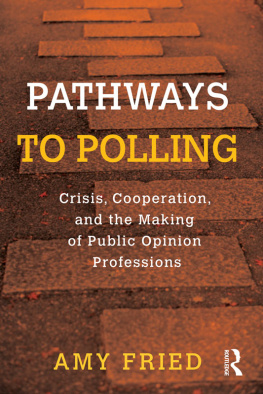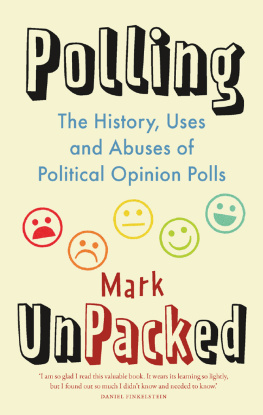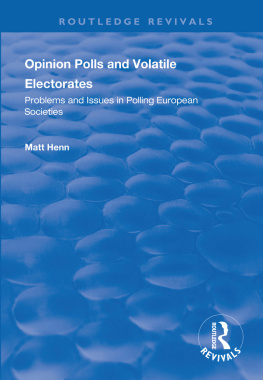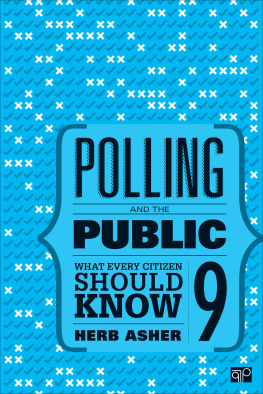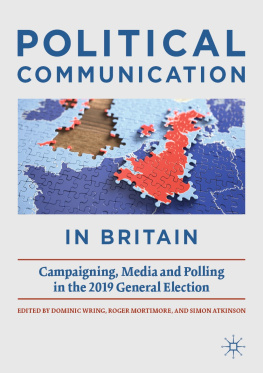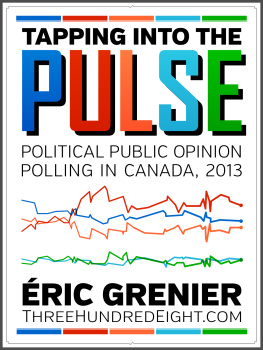PATHWAYS TO POLLING
In midcentury America, the public opinion polling enterprise faced a crisis of legitimacy. Every major polling firm predicted a win for Thomas Dewey over Harry Truman in the 1948 presidential electionand of course they all got it wrong. This failure generated considerable criticisms of polling and pollsters were forced to defend their craft, the quantitative analysis of public sentiment.
Pathways to Polling argues that early political pollsters, market researchers, and academic and government survey researchers were entrepreneurial figures who interacted through a broad network that was critical to the growth of public opinion enterprises. This network helped polling pioneers gain and maintain concrete, financial support to further their discrete operations. After the Truman-Dewey debacle, such links helped political polling survive when it could have just as easily been totally discredited. Amy Fried demonstrates how interactions between ideas, organizations, and institutions produced changes in the technological, political, and organizational paths of public opinion polling, notably affecting later developments and practice. Public opinion enterprises have changed a good deal in the intervening half century, even as todays approaches have been deeply imprinted by these early efforts.
Amy Fried is Professor of Political Science at the University of Maine.
PATHWAYS TO POLLING
Crisis, Cooperation and the Making of Public Opinion Professions
Amy Fried
First published 2012
by Routledge
711 Third Avenue, New York, NY 10017
Simultaneously published in the UK
by Routledge
2 Park Square, Milton Park, Abingdon, Oxon OX14 4RN
Routledge is an imprint of the Taylor & Francis Group, an informa business
2012 Taylor & Francis
The right of Amy Fried to be identified as author of this work has been asserted by her in accordance with sections 77 and 78 of the Copyright, Designs and Patents Act 1988.
All rights reserved. No part of this book may be reprinted or reproduced or utilised in any form or by any electronic, mechanical, or other means, now known or hereafter invented, including photocopying and recording, or in any information storage or retrieval system, without permission in writing from the publishers.
Trademark Notice: Product or corporate names may be trademarks or registered trademarks, and are used only for identification and explanation without intent to infringe.
Library of Congress Cataloging in Publication Data
Fried, Amy.
Pathways to polling : crisis, cooperation and the making of public opinion professions / Amy Fried.
p. cm.
1.Public opinion pollsUnited StatesHistory. 2. Public opinion pollsUnited StatesMethodologyHistory. I. Title.
HN90.P8F75 2011
001.433dc23
2011021539
ISBN13: 978-0-415-89141-7 (hbk)
ISBN13: 978-0-415-89142-4 (pbk)
ISBN13: 978-0-203-81496-3 (ebk)
To my David
TABLES
Preface and Acknowledgments
This project grew out a long-standing interest in the place of public opinion in American politics and society and a notion that the polling debacle of 1948 affected its growth and development. The 1948 pollsters were mercilessly mocked, as in this ditty, a parody of the Whiffenpoof song, belted out after Deweys concession by a group of champagne-drinking Democrats who seemed to barely believe what had unfolded: Gentlemen pollsters up in a tree, Damned from here to eternity God please save us from Tom Dewey Baa, baa, baa. Not only did Trumans defeat of Dewey stun people at the time, but it continues to intrigue the political imagination. Whenever a poll turns out to be wrong or questions are raised about whether a poll might be incorrect, pundits talk about the surprising result that gave Franklin Delano Roosevelts third vice president his own presidential term. Polls thus continue to be perceived as at least somewhat untrustworthy, unable to track political feelings and happenings. Yet since this dramatic event, surveys, polls, market research studies, and media audience analyses have only grown more numerous. How did these not only survive but thrive?
My initial efforts led me to look at the aftermath of 1948, an investigation which uncovered links between the pollsters and people doing similar work in other fields and established that many shared a sense of threat. But tracking what occurred in the period following the election only raised new questions. What had brought people from these different sectors together and why did they see their enterprises and futures as bound together? Other scholars had looked at how cultural and ideological currents contributed to the rise of polls, but, while important, these explanations focused on how the public came to accept polling. My interest turned to those who wanted to further pollings acceptance, as well as the validity of related activitiessurvey research, media audience research, and market research. (As a commenter who heard me present part of this project put it, the other explanations focused on demand, while mine focuses on supply.) Multiple partnersmarkets, the media, government, and academiafinanced and promoted the networks which supported and generated the polling industry. A number of details about the polling pioneers were known, but organizational and technological dynamics were missing in these accounts, as was a sense of how these activities within discrete sectors fit into larger trends involving their institutional homes.
This book looks at how the routes to a robust polling industry were carved out and how the pollsters and their colleagues in varied fields came together and diverged, producing the situation today in which there are numerous well-trained opinion researchers, active organizations which do this work, and ongoing efforts to track and influence the public. The pathways followed by these members of the network were influenced by dynamics involving the internal organization, professionalization, and scope of multiple sectors, the ways new technologies build on themselves, the availability of resources, and key historical events. While George Gallup touted polls as an instrument for democracy, organizations used public opinion data to serve their own needs, as this information was used both to meet citizens and consumers existing wants and to shape behaviors and desires. Although connections across sectors were cemented by shared projects during the twin crises of the Great Depression and World War II, in their aftermath, partners tended to drift apart and to develop their own organizational capacities and resource bases. Some links between pollsters and people in related fields have continued through organizations like the American Association of Public Opinion Research. However, opinion research has become more specialized, with practitioners focused on their sectors particular guiding standards, questions, and professional requisites, as they navigate what are now their own routes and pathways.
My own writing journey took me many places and leaves me grateful to many. My first research trip, to the Roper Papers at the University of Connecticut, was supported by a University of Maine Faculty Research Grant. In my stint as Associate Dean for the University of Maines College of Liberal Arts and Sciences, Dean Ann Leffler, who hired me for the position, was critically important in supporting the continuance of my scholarly work and in agreeing to provide funds for further trips to archives. I am appreciative that Interim Dean Gordon Kulberg and Dean Jeff Hecker honored those commitments and my integration of administrative and scholarly activities. While this combination had its strains, my time in academic administration brought with it insights about the practical, organizational, and political work involved in building, maintaining, and financing public opinion enterprises and in working in networks with people and organizations doing similar work. I also thank my department colleagues, particularly my chair, Tim Cole, for easing my transition back to my faculty position.

